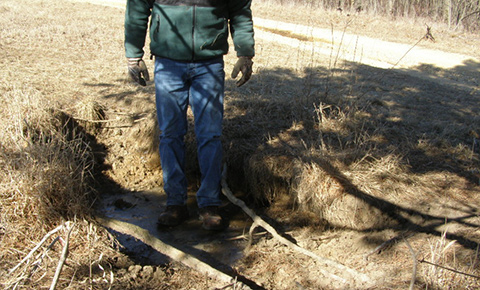CWD is a disease that can affect wild and captive cervids (deer, elk, moose, and caribou) in Iowa and is transmitted by a misfolded prion protein shed in saliva, nasal secretions, and other excreta. Prions are normal host proteins found throughout the body, however exposure to the infectious form can force a conformational shift that causes prions to aggregate in the brain. Prion diseases are uniformly fatal and pose a grave risk to long-term herd health in populations afflicted by this disease.
CWD can be transferred from deer to deer via direct contact and contact with bodily fluids, often months to years before individuals become symptomatic. Therefore, prevalence (proportion infected) and likelihood of spread often increase with deer density. However, environmental persistence and contamination can also cause disease, even years later. There is currently no viable vaccine or other treatment. Consequently, once a wild deer herd has become infected, eradication of disease is nearly impossible. Deer management strategies generally have focused on reducing the likelihood of transmission via population reduction while maintaining a quality recreational experience. Elsewhere in North AmericaCWD has been documented to have strong population-level impacts.
What Hunters Need to Know:
First detected in Allamakee County in 2013, CWD has been slowly increasing its footprint to include 23 counties and nearly 400 known positive wild deer. The Iowa DNR has been monitoring for CWD since 2002 and has increased effort in areas surrounding new detections and those with higher relative risks to help determine the presence and prevalence of the disease.
Though CWD testing is not regulated as a food safety test in the United States, it is our best way to keep these misfolded prions out of the human food chain. The Centers for Disease Control and Prevention (CDC) recommend those hunting in areas with CWD to strongly consider having their deer tested for CWD before eating the meat. If the deer tests positive, do not eat that animal. For further recommendations, refer to information provided by the
Centers for Disease Control and Prevention.
The Iowa DNR has created a number of special deer management zones that offer opportunities for hunters who are willing to harvest deer in specific areas.
This option is available to hunters both in- and out-of-state for cervids harvested in Iowa that either:
- Do not meet the DNR’s surveillance criteria (i.e. fawns)
- Are harvested in counties or management zones that have already exceeded surveillance quotas
Under Iowa law, hunters cannot transport into the state the whole carcass of any cervid (i.e., deer, elk, moose) taken from a CWD-infected area. Only the boned-out meat, the cape, and antlers attached to a clean skull plate (from which all brain tissue has been removed) are legal to transport into Iowa.
How to Help Stop the Spread:
Chronic Wasting Disease Ambassadors is a collaborative education program between the Iowa DNR and Iowa State University Extension and Outreach that seeks to help Iowans address the challenge of Chronic Wasting Disease. The goal of the program is to develop a small, connected, and well-educated network of local leaders to effectively communicate about the management and mitigation of CWD.
Hunters who harvest deer in counties where CWD has been confirmed can avoid unintentionally spreading disease to new areas by disposing of them at landfills when possible or burying them on the land where they were taken. Minimizing the movement of carcasses is good practice regardless of where you hunt.
CWD spreads from deer to deer through misfolded prion proteins shed in the saliva, feces, urine, and blood from infected deer that can last in the environment for years, spreading the disease long after the source deer is dead. To help prevent the spread, hunters are encouraged to avoid using attractants like mineral licks or bait that will congregate deer, thus potentially increasing disease transmission.
As a temporary measure, hunters can cover old mineral licks with pallets or fence them off to exclude deer. Permanent mitigation requires excavation and soil replacement to remove mineral that has leached deep into the ground.
